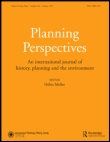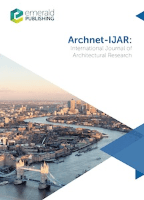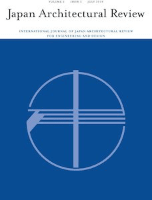
Open House International
Scope & Guideline
Illuminating Contemporary Challenges in Urban Development
Introduction
Aims and Scopes
- Sustainable Urban Development:
The journal emphasizes research on sustainable urban practices, including strategies for energy efficiency, green architecture, and climate-responsive design. - Cultural and Historical Contexts in Architecture:
It explores the influence of cultural and historical factors on architectural practices and urban design, particularly in relation to vernacular architecture and local identity. - Technological Integration in Design Education:
The journal investigates the integration of advanced technologies, such as virtual reality and machine learning, into architectural education and practice, enhancing design methodologies. - Community and Social Sustainability:
Research often focuses on the role of public spaces, community engagement, and participatory design in promoting social sustainability and improving urban life quality. - Spatial Analysis and Urban Planning:
The journal publishes studies involving spatial analysis methods and frameworks to address urban planning challenges and assess the impact of design on community well-being.
Trending and Emerging
- Smart Cities and Technology Integration:
A growing body of work addresses the integration of smart technologies in urban environments, focusing on enhancing livability and sustainability through innovative solutions. - Social Equity and Accessibility in Urban Design:
Recent publications increasingly emphasize the importance of social equity, exploring how urban design can support accessibility and improve quality of life for diverse populations. - Impact of COVID-19 on Urban Spaces:
The pandemic has prompted a surge in research examining the implications of COVID-19 on urban living, architectural design, and the functionality of public spaces. - Environmental Psychology and User Experience:
There is a rising interest in understanding how psychological factors influence user interactions with urban spaces, leading to a focus on well-being and mental health in design. - Community Participation and Governance in Urban Planning:
Emerging themes highlight the role of community involvement and participatory governance in shaping urban planning processes and outcomes, reflecting a shift towards collaborative approaches.
Declining or Waning
- Traditional Architectural Practices:
Research on traditional architectural methods and forms appears to be waning, possibly due to the increasing emphasis on modern technologies and sustainable practices. - Purely Theoretical Frameworks:
There is a noticeable reduction in publications that focus solely on theoretical frameworks without empirical application, as the journal increasingly values practical case studies and real-world implications. - Narrowly Defined Regional Studies:
Studies limited to very specific regional contexts are becoming less frequent, suggesting a trend towards broader, comparative analyses that can inform global practices.
Similar Journals

Architecture_MPS is a premier open-access journal published by UCL PRESS, dedicated to exploring the interconnections between architecture, urbanism, and the broader spectrum of social and cultural dynamics. Launched in 2012, this journal stands as a crucial platform for researchers, practitioners, and students alike, facilitating the exchange of innovative ideas and comprehensive scholarship in the field. With its commitment to open access, Architecture_MPS significantly enhances the visibility and accessibility of research, fostering a collaborative environment for academic discourse. The journal covers a diverse array of topics, including theoretical frameworks, policy analysis, and practical case studies, making it an invaluable resource for those engaged in the study and practice of architecture and allied disciplines. As a leading source of contemporary research, Architecture_MPS aims to bridge gaps between academia and practice, encouraging interdisciplinary dialogues that shape the future of architecture and urban studies.

ACE-Architecture City and Environment
Transforming Ideas into Sustainable Urban SolutionsACE-Architecture City and Environment, published by Universitat Politècnica de Catalunya in Spain, serves as an essential repository for innovative research and insights that intersect the fields of architecture, urban studies, and environmental planning. Since its establishment as an Open Access journal in 2006, it has facilitated widespread accessibility to scholarly work, fostering a collaborative and inclusive academic community. The journal has consistently maintained a prominent standing within its field, reflected in its 2023 Quartile rankings—, Q3 in Geography, Planning and Development, and Q2 in Urban Studies. With a publication horizon extending from 2011 to 2024 and an impressive Scopus ranking among peers, it offers a comprehensive platform for researchers to disseminate their findings and engage with contemporary challenges in urban environments. ACE is pivotal for professionals and students alike, striving to shape the future of sustainable architecture and urban planning through rigorous scholarship.

Planning Perspectives
Advancing Knowledge in Planning PracticesPlanning Perspectives is a prestigious journal published by Routledge Journals, Taylor & Francis Ltd, focusing on the dynamic fields of geography, planning, and development. With an ISSN of 0266-5433 and an E-ISSN of 1466-4518, this journal has been a vital resource for scholars since its inception in 1986, exploring diverse theoretical and practical dimensions of spatial planning and policy. As a respected Q2 journal within its category, it ranks 498 out of 821 in the Scopus database, placing it in the 39th percentile. Its commitment to driving the discourse in planning practices makes it an essential read for researchers, professionals, and students seeking to deepen their understanding of planning systems and spatial development. While it does not offer open access, access options are available through institutional subscriptions, making it accessible to a wide academic audience. Through in-depth articles, reviews, and research findings, Planning Perspectives continues to influence and shape the future of planning studies.

Archnet-IJAR International Journal of Architectural Research
Fostering collaboration in the global architectural community.Archnet-IJAR International Journal of Architectural Research serves as an esteemed platform within the field of architecture and urban studies, published by Emerald Group Publishing Ltd. With an impressive impact reflected through its Q1 category rankings in both Architecture and Urban Studies, this journal highlights cutting-edge research and innovative practices spanning diverse architectural disciplines. The journal focuses on facilitating interdisciplinary dialogues, making it a vital resource for researchers, students, and professionals keen on advancing their understanding of architectural theories and urban design. With its commitment to quality, evidenced by high scores in various Scopus rankings, including a rank of 9th in Visual Arts and Performing Arts, Archnet-IJAR aims to publish work that not only challenges conventional boundaries but also enriches practical applications in the built environment. Its open-access model ensures wider dissemination of knowledge, fostering collaboration and growth within the international architectural community.

i2 Investigacion e Innovacion en Arquitectura y Territorio
Connecting research and real-world applications in dynamic landscapes.i2 Investigacion e Innovacion en Arquitectura y Territorio is a leading open-access journal published by the University of Alicante, dedicated to advancing research and innovation in the fields of architecture and territorial development. Since its inception in 2013, this journal has aimed to provide a robust platform for scholarly discourse, promoting interdisciplinary approaches that connect academic insights with practical applications in urban planning and environmental design. With its commitment to accessibility, the journal ensures that cutting-edge findings and case studies are readily available to researchers, professionals, and students alike, fostering collaboration and informed decision-making. As the landscape of architecture and geography continues to evolve, the i2 journal stands out as a crucial resource for enhancing knowledge and cultivating innovative practices in these dynamic fields.

Manzar-The Scientific Journal of Landscape
Fostering Dialogue on Landscape DynamicsWelcome to Manzar - The Scientific Journal of Landscape, a premier academic outlet focusing on the interdisciplinary exploration of landscape studies, offering insights into art, architecture, and urbanism. Published by the NAZAR RESEARCH CENTER, this journal has been an Open Access platform since 2009, fostering free exchange of knowledge and supporting the dissemination of research in landscape architecture and urban studies. Renowned for its commitment to advancing scholarly dialogue, Manzar provides an essential resource for researchers, professionals, and students captivated by the complexities and aesthetics of landscapes. With an ISSN of 2008-7446 and E-ISSN of 2008-2169, the journal presents a diverse range of articles that investigate the interactions between natural and built environments. Located in Tehran, Iran, Manzar not only enhances local discourse but also contributes globally to the field of landscape studies.

Cuadernos de Vivienda y Urbanismo
Connecting Research to Urban RealityCuadernos de Vivienda y Urbanismo, published by the Pontificia Universidad Javeriana, Facultad de Arquitectura y Diseño, serves as a vital platform for researchers and practitioners in the fields of urban studies and planning. With a focus on the intricate relationships between housing, urban development, and social dynamics, this journal aims to foster interdisciplinary discourse and present innovative research that addresses contemporary urban challenges. Although its coverage on Scopus has been discontinued from 2012 to 2019, it continues to be an informative resource for understanding urban phenomena, evidenced by its rankings in the 24th percentile in Urban Studies and the 10th percentile in Geography, Planning and Development. Scholars and professionals are encouraged to explore the rich repository of articles that reflect both local and global contexts, providing insights that inform policy and practice in urban environments.

Bagh-e Nazar
Exploring the Intersection of Art and UrbanismBagh-e Nazar is a distinguished academic journal dedicated to the fields of art, architecture, and urbanism, published by the NAZAR RESEARCH CENTER in Tehran, Iran. With a focus on promoting scholarly research and innovative ideas, this journal serves as a platform for critical discussions and diverse perspectives on contemporary artistic and architectural practices. The journal is indexed under ISSN 1735-9635 and E-ISSN 2251-7197, reflecting its commitment to high academic standards and international visibility. Although currently not open access, it seeks to provide comprehensive insight into the socio-cultural dynamics influencing urban environments and artistic expressions. By bridging theory and practice, Bagh-e Nazar plays a pivotal role in advancing knowledge and fostering dialogue within the vibrant domains of art and architecture, making it an invaluable resource for researchers, professionals, and students alike.

Contexto-Revista de la Facultad de Arquitectura Universidad Autonoma de Nuevo Leon
Connecting Research, Practice, and Visual ArtsContexto-Revista de la Facultad de Arquitectura Universidad Autonoma de Nuevo Leon is a prominent open-access journal published by the Universidad Autonoma de Nuevo Leon, Faculty of Architecture, dedicated to the fields of architecture, urban studies, and visual arts. Since its establishment, the journal has steadily contributed to the discourse in these interconnected domains, particularly given its commitment to open access since 2011, allowing for wider dissemination of knowledge and research. With its ISSN 2007-1639, Contexto has evolved to encompass a range of topics pertinent to contemporary architectural practices and urban development trends, reflecting its vision to foster innovative dialogues and critical analyses among researchers, practitioners, and students. With a current Scopus ranking showcasing its influence—specifically a Q4 classification in Architecture and Urban Studies, and a Q2 in Visual Arts and Performing Arts—this journal serves as a vital resource for academia and industry alike. Authors and readers are encouraged to engage with its dynamic content and contribute to its ongoing mission of enriching the architectural and urban narratives within Mexico and beyond.

Japan Architectural Review
Exploring the intersection of architecture and environmental engineering.Japan Architectural Review is a premier open-access journal published by WILEY, dedicated to advancing the fields of architecture, environmental engineering, and modeling and simulation. Since its inception, this journal has emerged as a critical platform for disseminating innovative research, offering insights into the latest trends and challenges facing the built environment and sustainability practices. With an impact factor reflecting its growing influence, especially in the Q2 category of Architecture and notable rankings in environmental engineering and modeling disciplines, it serves as an essential resource for researchers, professionals, and students alike. The journal's commitment to open access since 2018 has further enhanced its reach, making high-quality research accessible to a global audience. Spanning an important timeline from 2019 to 2024, the Japan Architectural Review facilitates a collaborative discourse among scholars, encouraging innovative solutions to contemporary architectural challenges.